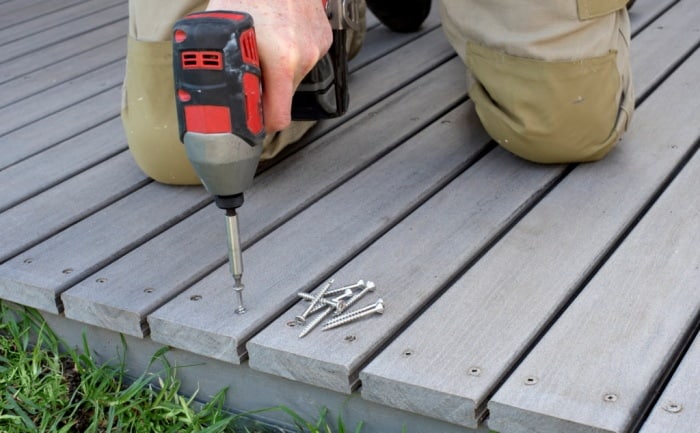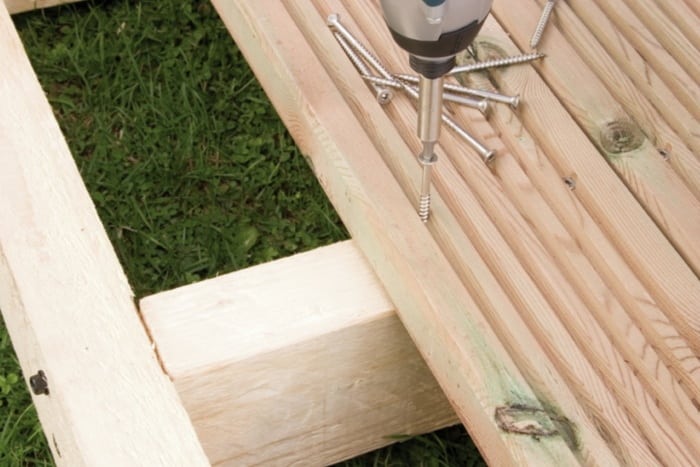Before taking on a decking project, you should gather all necessary materials first to avoid wasting effort and time running to a hardware store.
Since you’re going to use screws throughout the assembly process, preparing them beforehand is a must.
But how many screws per deck board should you riddle with? We frequently receive this question as choosing the correct number and type of fastener for composite decking is somewhat time-consuming.
In general, you should fasten one deck board with two fasteners at either point so that it’ll attach firmly to the joist.
However, we can’t tell for sure the total number of screws you’ll need for your personalized deck. We suggest taking some measurements to determine it precisely. Let us show you how!
How Many Screws Per Deck Board Do I Need?
Deck boards will be exposed to such harsh weather conditions that they can get susceptible to crowning, cupping, or warping.
The fasteners are the things that support your deck and help it withstand the factors wreaking havoc on it. So, it’s essential to use the right amount to enhance the decking’s durability and stability.
That amount largely depends on your board’s size, the screw’s size, and the screw type you’re using. Typically, larger decks will need more fasteners than smaller ones.
The traditional thumb rule is that a deck board of six inches with 16 joists should have 350 fasteners for every 100 square feet.
This calculation may not be precise in all situations. You can’t tell exactly the amount of fasteners until you complete the task.
There are three basic steps to help you calculate the approximate number of screws you will need.
Remember to buy in a bit larger quantity, as running out of fasteners is pretty infuriating when you’re about to finish.
Measure the deck
To determine the right amount, first, you need to measure the width and length of your deck, or in a word, how entirely large it is. This step will let you accurately estimate the deck’s square footage.
Measure the joist spacing
Joists are the deck’s skeleton bones, holding the planks on it firmly in place. Next, you’ll need to measure the width and length of each deck board and calculate the number of deck boards you’re going to use to install the deck.
Calculate how many fasteners you need
The final step is to count the screws you need at joist intersections one by one. As mentioned, you should fasten each intersection with two screws.
So, you’ll figure out the total number based on the planned design of your deck. The math exam will be two fasteners per joist intersection x the number of joists x deck boards.
How To Choose The Right Type of Screw For Decking
Some home craftsmen use nails as an alternative to screws for their decking project. Nails will work finely and even more quickly if you take advantage of a power framing nailer.
Read More:Finish Nailer Vs. Framing Nailer – Which One Is Best For You?
Nonetheless, nails are not really good for securing the deck because they tend not to stick to the board for an extended period.
Over time, nails jumping out of wood will cause the board to go loose and require constant maintenance.
Meanwhile, screws can keep deck boards tightly for longer as they’re thread. That’s why screws appear to be the more excellent choice for your ambitious project, as long as you pick the right type.
Reaching any brick-and-mortar hardware store, you’ll easily find hundreds of fasteners of all sorts and sizes for all kinds of projects.
Looking for suitable ones seems to be an easy task at first glance, but it turns out to be quite complicated.
Decking Material
Your deck’s material is among the factors deciding the screws you have to buy. It’ll be nice if you use stainless steel, wood, or galvanized deck screws to riddle with treated lumber.
Pressure-treated lumber recently has been made with two copper-based wood preservatives.
Although these preservatives are good at deterring the furniture from rotting, they will corrode standard metal screws, basically leading to a structural failure in the deck.
For cedar decks, either stainless steel or hot-dipped galvanized deck screws are a great option.
Please remember, you have to fasten composite decking with composite deck fasteners. Wood screws tend to dig a hole through the deck rather than biting and sticking to it.
Composite screws, on the other hand, will fasten your composite deck boards, attaching them tightly to the framing.
When selecting the screws, keep in mind that they’ll be visible, hence the color matter. Standard wood board fasteners are grey, while deck screws come in a broad range of colors.
So, it’s necessary to decide which one looks nice for your deck’s style and color.
Types of Deck Screw Heads
You’ll see screw heads also come with various shapes, such as squares, stars, or standard Phillips-head ones. They all do the job, but some will speed up the progress.
In particular, the square screw heads may reduce the wood’s subsequent slippage tripping, which can apply to Phillips-head screws.
Also, star drive heads, or Torx screws, generate six contact points with a compatible drill tip, being more recessed than the Phillips-head type, delivering more torque, stability, and driving power.
In a word, choosing the right sort of deck screw head will push the installing process to be faster.
Conclusion
Figuring out how many screws per deck board you need is a nuisance without proper calculation.
A minor mistake can hurt the beauty of the desired result, so count and prepare enough deck screws for your work in advance.
We’re so excited to share with you helpful estimation methods so that the decking task becomes a fun job for you. Make sure to read this content attentively to get interesting fastening tips.
Now, let’s rock in your home improvement project!



